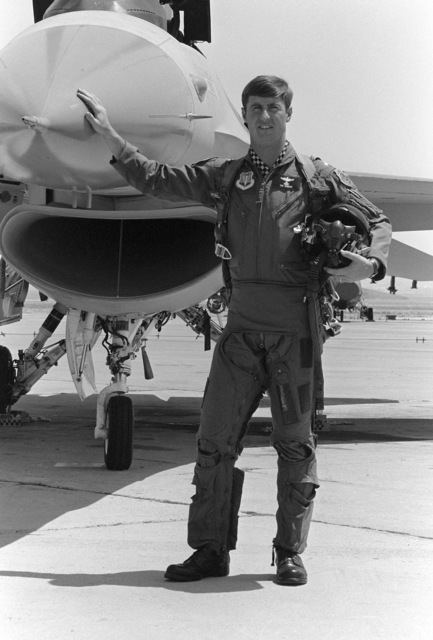Nationality American Time in space 42d 18h 38m | Name Terence Henricks Status Retired Mission insignia | |
 | ||
Similar People Kevin R Kregel, Mario Runco - Jr, Thomas J Hennen, Mary Ellen Weber, Nancy J Currie | ||
1995: Space Shuttle Flight 70 (STS-70) Discovery (NASA)
Terence Thomas "Tom" Henricks (born July 5, 1952) is a retired colonel in the United States Air Force and a former NASA astronaut. He served on four Space Shuttle missions.
Contents
- 1995 Space Shuttle Flight 70 STS 70 Discovery NASA
- STS 78 Post Flight Presentation
- Personal life and education
- Special honors
- Military and flight experience
- NASA experience
- Space flight experience
- References

STS-78 Post Flight Presentation
Personal life and education
Henricks was born on July 5, 1952 in Bryan, Ohio to Terry and Martha Henricks, but considers Woodville, Ohio to be his hometown. He graduated from Woodmore High School in 1970. He received his Bachelor of Science degree in civil engineering from the United States Air Force Academy in 1974 and his Master of Public Administration degree from Golden Gate University in 1982. He is married and has three children. He now resides in a small town outside of Waco, Texas, with his wife Julie.
Special honors
Military and flight experience
Henricks completed pilot training at Craig Air Force Base (AFB) in Selma, Alabama, and F-4 Phantom II conversion training at Homestead AFB in Miami, Florida. He then flew the F-4 in fighter squadrons in England and Iceland. In 1980, he was reassigned to Nellis AFB, Las Vegas, Nevada. After attending the USAF Test Pilot School in 1983, he remained at Edwards AFB, California, as an F-16C test pilot and Chief of the 57th Fighter Weapons Wing Operating Location until his NASA selection. He has 749 parachute jumps and a Master Parachutist rating. He has flown 30 different types of aircraft, has logged over 6,000 hours flying time, and holds an FAA commercial pilot rating.
NASA experience
Selected by NASA in June 1985, Henricks became an astronaut in July 1986. His technical assignments to date include: re-evaluating Shuttle landing sites worldwide; Assistant Manager for Engineering Integration in the Shuttle Program Office; Lead Astronaut of the Shuttle Avionics Integration Laboratory at Johnson Space Center, and of Vehicle Test and Checkout at the Kennedy Space Center; Chief of the Astronaut Office Operations Development Branch. He also served as the Assistant for Shuttle to the Chief of the Astronaut Office, directing crew involvement in the development and operation of the Shuttle. A commander of two Space Shuttle missions and pilot of two others, Henricks became the first person to log over 1,000 hours as a Space Shuttle pilot/commander. Tom Henricks left government service in November 1997 to pursue a career in business. He held the position of President of McGraw-Hill's Aviation Week, based in New York City until his departure in 2010 to pursue other opportunities.
Space flight experience
STS-44 Atlantis launched the night of November 24, 1991. The primary mission objective was the deployment of a Defense Support Program (DSP) satellite with an Inertial Upper Stage (IUS) rocket booster. The mission was concluded after 110 orbits of the Earth returning to a landing on the lakebed at Edwards Air Force Base, California, on December 1, 1991.
STS-55, the German D-2 Spacelab mission, was launched on April 26, 1993, aboard Columbia, and landed 10 days later on May 6, 1993, at Edwards AFB California. During the ambitious mission 89 experiments were performed in many disciplines such as materials processing, life sciences, robotics, technology, astronomy, and Earth mapping.
STS-70 launched from the Kennedy Space Center, Florida, on July 13, 1995, and returned there July 22, 1995. During 142 orbits of the Earth, the crew performed a variety of experiments in addition to deploying the sixth and final NASA Tracking and Data Relay Satellite. STS-70, with an "all-Ohio" crew, was the first mission controlled from the new combined control center.
STS-78 launched June 20, 1996 and landed July 7, 1996 becoming the longest Space Shuttle mission to date (later that year the STS-80 mission broke its record by 19 hours.) The 16-day mission included studies sponsored by 10 nations and five space agencies, and was the first mission to combine both a full microgravity studies agenda and a comprehensive life science investigation. The Life and Microgravity Spacelab mission served as a model for future studies on board the International Space Station.
